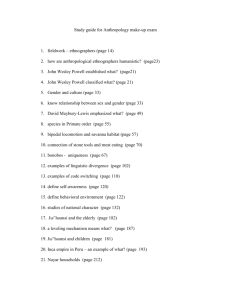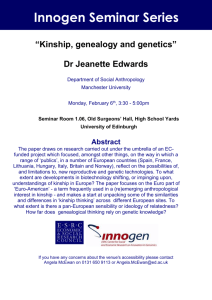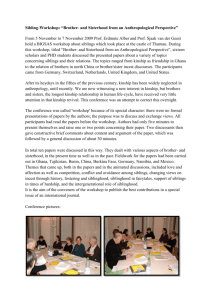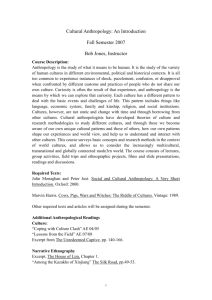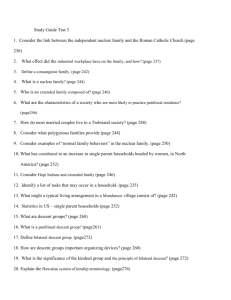Muddled Models and Unruly Realities: The Epistemology of
advertisement
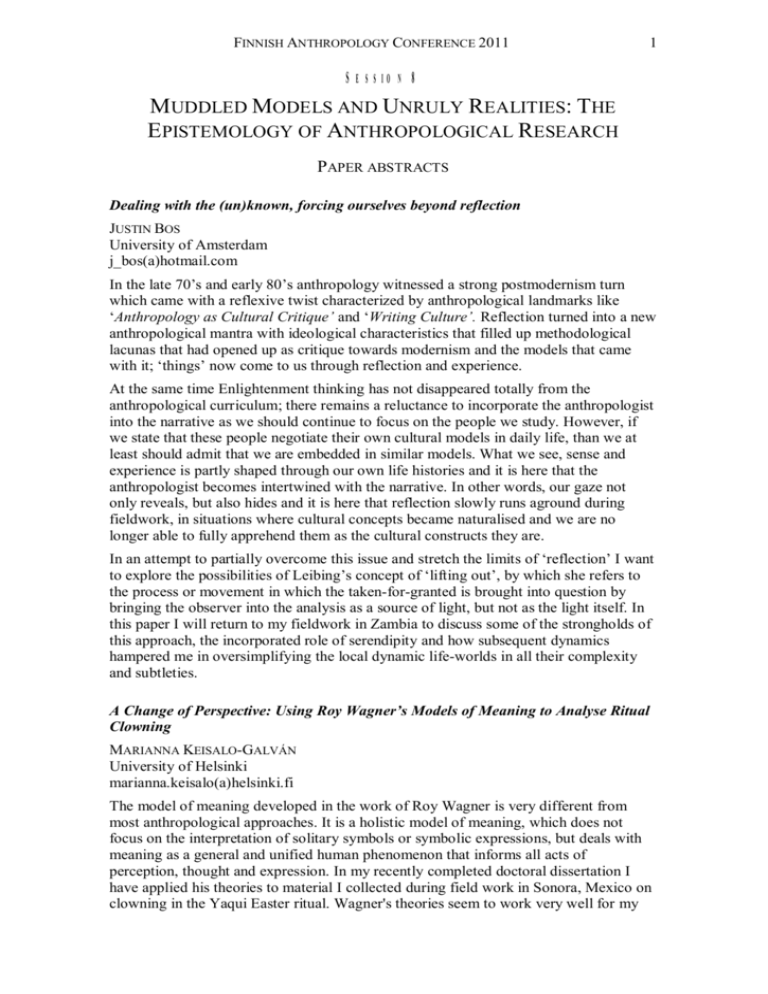
FINNISH ANTHROPOLOGY CONFERENCE 2011 1 SESSION 8 MUDDLED MODELS AND UNRULY REALITIES: THE EPISTEMOLOGY OF ANTHROPOLOGICAL RESEARCH PAPER ABSTRACTS Dealing with the (un)known, forcing ourselves beyond reflection JUSTIN BOS University of Amsterdam j_bos(a)hotmail.com In the late 70’s and early 80’s anthropology witnessed a strong postmodernism turn which came with a reflexive twist characterized by anthropological landmarks like ‘Anthropology as Cultural Critique’ and ‘Writing Culture’. Reflection turned into a new anthropological mantra with ideological characteristics that filled up methodological lacunas that had opened up as critique towards modernism and the models that came with it; ‘things’ now come to us through reflection and experience. At the same time Enlightenment thinking has not disappeared totally from the anthropological curriculum; there remains a reluctance to incorporate the anthropologist into the narrative as we should continue to focus on the people we study. However, if we state that these people negotiate their own cultural models in daily life, than we at least should admit that we are embedded in similar models. What we see, sense and experience is partly shaped through our own life histories and it is here that the anthropologist becomes intertwined with the narrative. In other words, our gaze not only reveals, but also hides and it is here that reflection slowly runs aground during fieldwork, in situations where cultural concepts became naturalised and we are no longer able to fully apprehend them as the cultural constructs they are. In an attempt to partially overcome this issue and stretch the limits of ‘reflection’ I want to explore the possibilities of Leibing’s concept of ‘lifting out’, by which she refers to the process or movement in which the taken-for-granted is brought into question by bringing the observer into the analysis as a source of light, but not as the light itself. In this paper I will return to my fieldwork in Zambia to discuss some of the strongholds of this approach, the incorporated role of serendipity and how subsequent dynamics hampered me in oversimplifying the local dynamic life-worlds in all their complexity and subtleties. A Change of Perspective: Using Roy Wagner’s Models of Meaning to Analyse Ritual Clowning MARIANNA KEISALO-GALVÁN University of Helsinki marianna.keisalo(a)helsinki.fi The model of meaning developed in the work of Roy Wagner is very different from most anthropological approaches. It is a holistic model of meaning, which does not focus on the interpretation of solitary symbols or symbolic expressions, but deals with meaning as a general and unified human phenomenon that informs all acts of perception, thought and expression. In my recently completed doctoral dissertation I have applied his theories to material I collected during field work in Sonora, Mexico on clowning in the Yaqui Easter ritual. Wagner's theories seem to work very well for my FINNISH ANTHROPOLOGY CONFERENCE 2011 2 study and have provided new insight to ritual clowning performance. At the same time, the perspective this model provides is so distinct that situating my work in the context of anthropology and the study of ritual becomes somewhat problematic, both in terms of relating Wagner to other theoretical models and how I use that model in my own work. In this paper I will explore some of the differences and similarities between Wagner and other approaches to ritual and ask, what exactly does the change of perspective involved in the change of theoretical model entail in the case of ritual clowning? Heuristic Necessities or What: Identification of Multiple Theoretical and Empirical Grounds for the Use of the North-South –Dichotomy in Ethnographic Literature Concerning Kinship and Hierarchy in India TOUKO MARTIKAINEN University of Helsinki touko.martikainen(a)helsinki.fi My doctoral thesis concerns the function of two competing theories of Indian caste system in the establishment of empirical arguments concerning particular ethnographic cases. As a part of this project, I examine in this presentation the autonomy of kinship terminology as an analytical domain in the early ethnographic literature by Louis Dumont and in two subsequent research projects by other anthropologists. While both of these projects criticize Dumont’s work, they do this in different ways. One body of work deals with structural variation of certain kinship terminologies of India in terms of structural evolution. Here, kinship terminology holds certain autonomy with regard to other dimensions of language and social life. Dumont’s efforts to bridge the gap between North and South India are criticized in part by reference to this autonomy and the critique simultaneously makes positive use of the division between North and South India. Another body of work under my focus is a comparative effort dealing with material from Tamil Nadu and Bengal. In this ethnographic project the aim is to allow indigenous categories influence the construction of kinship as an analytical domain. Dumont’s dichotomy between North and South India is here deemed unhelpful. In addition, the kind of autonomy Dumont’s analysis grants to kinship is questioned as other conceptual structures are deemed more capable for comparing Tamil Nadu and Bengal. Applying literature on stability and theoretical robustness from philosophy of science to ethnographical corpus, I identify differing functions of kinship terminology vis-à-vis other domains of language and kinship as a phenomena of sociocultural structure. Deconstructing Kinship and Hierarchy in Samoa: Confusion over Genealogical Models HARRI SIIKALA University of Virginia harrisiikala(a)gmail.com The islands cultures of Polynesia with their shared migratory origins coupled with subsequent geographical isolation have long interested anthropologists seeking to create models for controlled comparison of cultural variance. In the context of these comparative schema Samoa has usually stood out as an anomaly. Fierce debates have raged over the degree of political centralization and the nature of traditional descent groups. Some scholars claimed that political power in Samoa was unusually dispersed with no overarching hierarchical organization, and that unlike in the usual Polynesian ramage systems descent groups were relatively small and not ranked according to FINNISH ANTHROPOLOGY CONFERENCE 2011 3 primogeniture. Other researchers insisted that the concept of a single national authority existed in Samoa, and stressed the ramified nature of dispersed chiefly genealogies which established supra-village political authority according to descent group lines. Since the heyday of descent theory interest in the debate has somewhat subsided, while a more nuanced historical understanding of post-contact changes in Samoan society has shifted the focus away from the “arcane” issues of kinship. Still, key assumptions about Samoa left over from the debate linger in anthropological analysis. In my paper I attempt to shed light on why anthropologists came to such differing conclusions about hierarchy and social structure in Samoa. The gap between the abstract theoretical models and the pragmatic contingencies of specific circumstances and the political maneuvering on the ground allow for great leeway for interpretations. Furthermore, a similar gap exists between the Samoan indigenous representations of tradition, the idealized Samoan way, and the actual practices which greatly differ from village to village. Anthropological Models in the Analysis of Skolt Sami Reindeer Herding PANU ITKONEN University of Helisnki pitkonen(a)mappi.helsinki.fi

